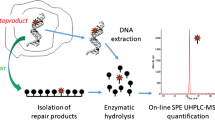Abstract
The in vivo genotoxic activities in mouse skin of the dimethyl sulphoxide (DMSO) extracts of a range of oil products [residual aromatic extract; untreated heavy paraffinic distillate aromatic extract; mildly refined light naphthenic base oil; bitumen (vacuum residue); high viscosity index base oil obtained by catalytic hydrogenation] were evaluated by 32P-postlabelling DNA analysis. The results of quantitative 32P-postlabelling analyses of epidermal DNA from mice treated with the DMSO extracts showed linear relationships with the total polycyclic aromatic compound (PAC) contents, determined by the Institute of Petroleum method IP 346 and also the 3–6 ring PAC contents, measured by on-line liquid-liquid extraction using flow injection analysis. The 32P-postlabelling data also showed a linear relationship with the mutagenicity indices of these oil products determined in S. typhimurium TA98 using the modified Ames Salmonella microsome test. The in vivo genotoxicity of the DMSO extracts from the oil products was low, judged by 32P-postlabelling analysis of DNA adducts measured in epidermal DNA of treated mouse skin, and ranging from 2 to 723 attomole/μg DNA per mg oil product. The in vivo 32P-postlabelling data from this study are consistent with these materials expressing low genotoxicity in mouse skin in vivo. The DMSO extraction procedure coupled with 32P-postlabelling DNA analysis is useful for ranking the relative genotoxic potency in vivo of a wide range of oil products. In general the trend observed is similar to rankings based on physicochemical measurements of␣total PAC contents or 3–6 ring PAC contents of the oil products.
Similar content being viewed by others
Author information
Authors and Affiliations
Additional information
Received: 11 February 1998 / Accepted: 2 April 1998
Rights and permissions
About this article
Cite this article
Booth, E., Brandt, H., Loose, R. et al. Correlation of 32P-postlabelling-detection of DNA adducts in mouse skin in vivo with the polycyclic aromatic compound content and mutagenicity in Salmonella typhimurium of a range of oil products. Arch Toxicol 72, 505–513 (1998). https://doi.org/10.1007/s002040050535
Issue Date:
DOI: https://doi.org/10.1007/s002040050535




